
8 Best Productivity Apps for Your Team In 2024 (Free & Paid)
-
by Anoop Singh
- 4
- Best for timeline management: Asana
- Best for enterprise workflows: Wrike
- Best for online collaboration: Notion
- Best for simple collaboration: Todoist
- Best for managing team performance: Teamwork
- Best for complex time management: TimeCamp
- Best for employee time tracking: Toggl Track
- Best for workflow management: ClickUp
The right software will increase your team’s productivity rather than decrease it, helping to speed up workflows and eliminate repetitive tasks. Since there are more productivity apps on the market than ever before, choosing the right one for your team’s size, needs and budget can be daunting.
To help you out, we’ve rounded up the best productivity apps for teams of various sizes and highlighted their most important features.
1
monday.com
Employees per Company Size
Micro (0-49), Small (50-249), Medium (250-999), Large (1,000-4,999), Enterprise (5,000+)
Any Company Size
Any Company Size
Features
Agile Development, Analytics / Reports, API, and more
2
Quickbase
Employees per Company Size
Micro (0-49), Small (50-249), Medium (250-999), Large (1,000-4,999), Enterprise (5,000+)
Small (50-249 Employees), Medium (250-999 Employees), Large (1,000-4,999 Employees), Enterprise (5,000+ Employees)
Small, Medium, Large, Enterprise
Features
Agile Development, Analytics / Reports, API, and more
3
Wrike
Employees per Company Size
Micro (0-49), Small (50-249), Medium (250-999), Large (1,000-4,999), Enterprise (5,000+)
Medium (250-999 Employees), Large (1,000-4,999 Employees), Enterprise (5,000+ Employees)
Medium, Large, Enterprise
Features
Agile Development, Analytics / Reports, API, and more
Top productivity apps comparison
In the chart below, we highlight some of the most important features to consider besides price when it comes to choosing a productivity app.
| Time tracking | Gantt charts | Automation | AI assist | Pricing | |
|---|---|---|---|---|---|
| Asana | Limited | Yes | Yes | Yes, writing | $10.99 per user per month |
| Wrike | Yes | Yes | Yes | Yes, multi-uses | $9.80 per user per month |
| Notion | No | No | Yes | Yes, AI writing add-on | $8 per user per month |
| Todoist | Limited | No | No | Yes, tasks and filters | $4 per user per month |
| Teamwork | Yes | Yes | Yes | Yes, predictive analytics | $9.99 per user per month |
| TimeCamp | Yes | Yes | Yes | No | $2.99 per user per month |
| Toggl Track | Yes | No | Yes | No | $9 per user per month |
| ClickUp | Yes | Yes | Yes | Yes, writing | $7 per user per month |
Asana: Best for timeline management

Asana is a popular productivity app that includes tools reporting, automation and project management. In Asana, users can see timelines, set task dependencies, use templates, build workflows and leverage their intelligence tools for editing.
Teams with long-term projects and important deadlines will greatly benefit from the application. The free plan also offers unlimited tasks and projects for up to 10 people, making it one of the best free productivity apps as well.
For more information, check out our full Asana review.
Pricing
- Basic: Free for small teams, unlimited projects and messaging.
- Premium: $10.99 per user per month, billed annually, or $13.49, billed monthly.
- Business: $24.99 per user per month, billed annually, or $30.49, billed monthly.
- Enterprise: For bigger teams with plenty of data — see sales for more information.
Features
- Project tracking tools such as timelines, due dates, easy assigning, custom rules and milestones.
- Approvals and task dependencies keep projects organized.
- Unlimited free guests for paid plans.
- Workflow automation via rules and bundles.

Top integrations
- Slack.
- Dropbox.
- Google Drive.
- Microsoft Teams.
- Salesforce.
- OneDrive.
- Dropbox.
- Zendesk.
Pros and cons
| Pros | Cons |
|---|---|
|
|
Why we chose Asana
Asana offers multiple features to help you manage the timelines of your projects and stay on top of your deadlines, including a Gantt chart view and task dependencies. The free plan is also pretty generous and will suffice for teams of less than 10 people.
Wrike: Best for enterprise workflows

Wrike is one of the most well-known productivity apps, and it comes with a number of tools to support project management and efficient workflows. Some of the features offered include time tracking, data visualization, automation, reporting, task management and artificial intelligence. Their free version is great for teams starting out, and Wrike also offers not one but two enterprise plans to meet the needs of large organizations.
For more information, read the full Wrike review.
Pricing
- Free: Unlimited users and 2 GB of storage space.
- Team: $9.80 per user per month, billed annually.
- Business: $24.80 per user per month, billed annually.
- Enterprise: Enterprise-level security — see sales for more.
- Pinnacle: Advanced analytics for complex data — see sales for more.
Features
- Choose from multiple project views, including calendars, Gantt charts, tables and kanban.
- Artificial intelligence enhances smart search, text and tasks.
- Time tracking, resource assignment and workload charts to manage resources.
- Collaborator and guest users for unified communication.
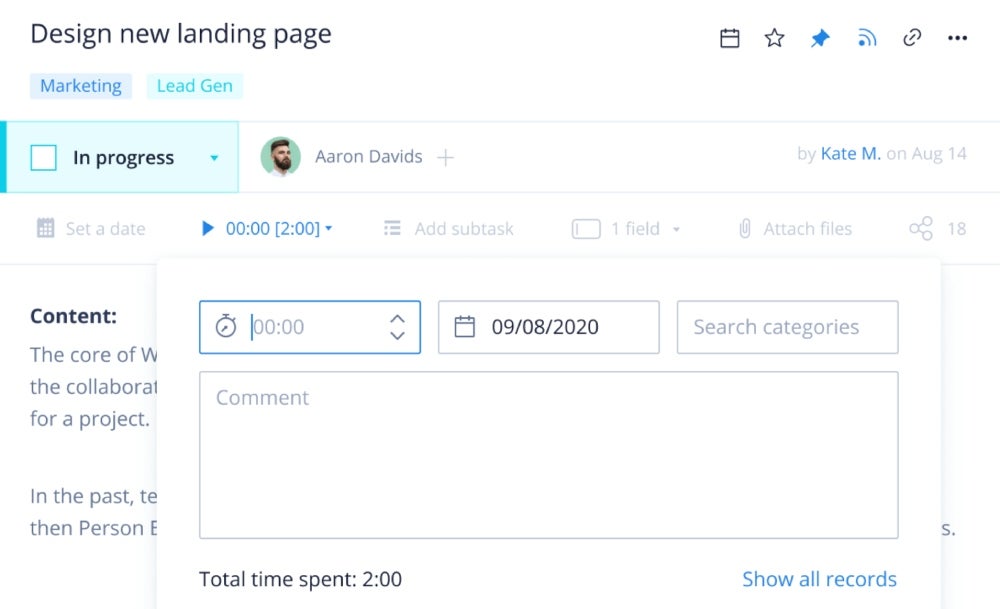
Top integrations
- Google Drive.
- Zoom.
- Miro.
- Microsoft OneDrive.
- Tableau.
- Slack.
- Dropbox.
Pros and cons
| Pros | Cons |
|---|---|
|
|
Why we chose Wrike
While Wrike does offer entry-level plans geared towards smaller teams on a budget, its more expensive plans offer a wide array of features that are well suited to the needs of large businesses. It also provides two different enterprise pricing plans to choose from, so you can select the level of service that’s the best fit for your needs and budget.
Notion: Best for online collaboration
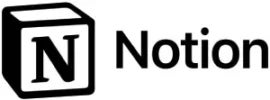
Notion is a great tool for digital collaboration and communication that combines a note taking app with project management. Whether you’re remote, hybrid or in-person, you can use Notion to improve virtual productivity and workflows.
Notion includes standard project management features like timeline and Kanban boards, and it also offers content creation features that you can use for note taking or wiki building. All plans also come with a certain number of guest collaborators to support online collaboration.
For more information, check out our full Notion review and our Obsidian vs. Notion comparison.
Pricing
- Free: Unlimited blocks for one user.
- Plus: $8 per user per month billed annually, or $10 billed monthly.
- Business: $15 per user per month billed annually, or $18 billed monthly.
- Enterprise: More support and customization — see sales to learn more.
Features
- Choose from multiple project views like list, kanban and table.
- Automation for workflow and databases.
- Public API to build custom integrations with your favorite apps.
- Database syncing and link previews.

Top integrations
- Google Drive.
- Slack.
- Splunk.
- Calendly.
- Gusto.
- OneDrive.
- Zoom.
- Box.
- Okta.
Pros and cons
| Pros | Cons |
|---|---|
|
|
Why we chose Notion
Notion’s focus on content creation and digital collaboration makes it uniquely suited for online and remote teams. Choosing Notion means you won’t have to get a separate wiki building or note taking app. Instead, you can use this single productivity app for all your project management.
Todoist: Best for simple collaboration

If you are mostly in need of simple task management and collaboration, rather than a complex productivity app with many advanced features, definitely check out Todoist. This app functions as a digital to-do list that makes it easy to keep track of everything you need to accomplish
It also offers tools for simple collaboration, so you can share your to-do lists with a family member or your work colleagues. Pricing plans are affordable, and Todoist also offers a limited free plan so you can test it out before committing.
For more information, read the full Todoist review.
Pricing
- Beginner: Free for one user, allows 5 active projects.
- Pro: $4 per user per month billed annually, or $5 billed monthly.
- Business: $6 per user per month billed annually, or $8 billed monthly.
Features
- AI assistant for task management and filtering.
- Task time tracking to stay on top of workflows.
- Theme customization to improve workspace.
- Advanced role permissions, guest users and centralized billing for contractor management.
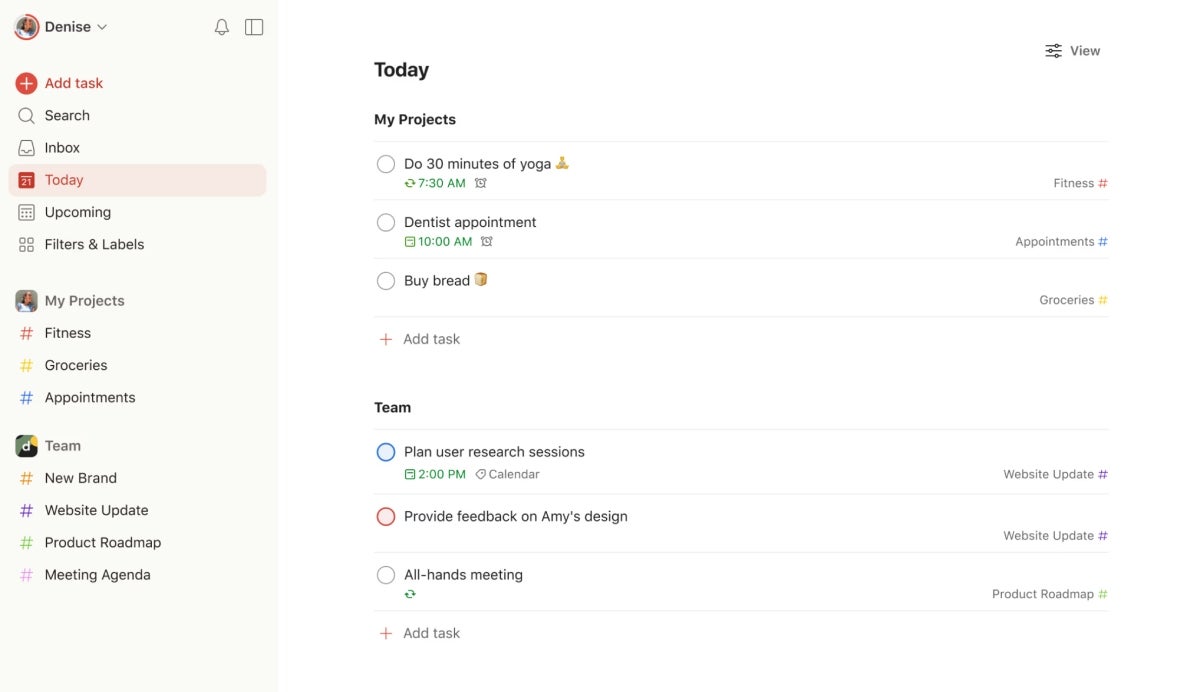
Top integrations
- Outlook.
- Everhour.
- Toggl.
- Trello.
- Gmail.
- Slack.
- Microsoft Teams.
Pros and cons
| Pros | Cons |
|---|---|
|
|
Why we chose Todoist
Todoist is an excellent choice for beginners looking to get started with daily task management and productivity apps. While it doesn’t offer as many features as some of the other options on this list, it does present a very low learning curve and an intuitive user interface design, making it easy for beginners to master.
Teamwork: Best for managing team performance

True to its name, Teamwork offers many features to help you improve employees’ work-life balance and overall performance. This productivity app has features for managing time, resources, budgets, projects, communication and team needs. Teamwork also offers specific features for agencies and client-facing teams, such as a client portal and time tracking for billable hours, making it a great option for those kinds of teams as well.
For more information, read the full Teamwork review.
Pricing
- Free Forever: $0 per month for up to five users.
- Starter: $5.99 per user per month billed annually, or $8.99 per user per month billed monthly. A free trial is available.
- Deliver: $9.99 per user per month billed annually, or $13.99 per user per month billed monthly. A free trial is available.
- Grow: $19.99 per user per month billed annually, or $25.99 per user per month billed monthly. A free trial is available.
- Scale: Quote available upon request.
Features
- Time management via time tracking, time estimates, reminders and billable time tracking.
- Budget management for time, expenses, invoices and tasks.
- Team resource management for managing employee workloads.
- Project management tools like templates, collaborator users, team chats and even automation.

Top integrations
- HubSpot.
- Microsoft Teams.
- Slack.
- Stripe.
- Mailchimp.
- Outlook.
- Box.
- DropBox.
Pros and cons
| Pros | Cons |
|---|---|
|
|
Why we chose Teamwork
Teamwork offers an excellent selection of features that can be used to manage projects and improve team performance. It also has tools to support agencies and client-facing teams, as well as advanced project management features such as budgeting and resource management.
TimeCamp: Best for complex time management

If time management is the main feature you’re looking for in a productivity app, then check out TimeCamp. You can use TimeCamp’s tools for employee time tracking, budgeting, reporting and project organization. The application is also budget-friendly and allows unlimited users in their Free subscription, meaning that teams will be able to extensively test out the app’s productivity features before making big commitments.
Pricing
- Free: Allows unlimited users and unlimited projects.
- Starter: $2.99 per user per month billed annually, or $3.99 billed monthly.
- Premium: $4.99 per user per month billed annually, or $6.99 billed monthly.
- Ultimate: $7.99 per user per month billed annually, or $10.99 billed monthly.
- Enterprise: $11.99 per user per month billed annually, or $14.99 billed monthly.
Features
- Many time management tools such as idle time tracking, overtime tracking, billable time tracking, budgeting and more.
- Unlimited projects, tasks and teams to accommodate most workloads.
- Website and window tracking.
- GPS tracking and geoconferencing.
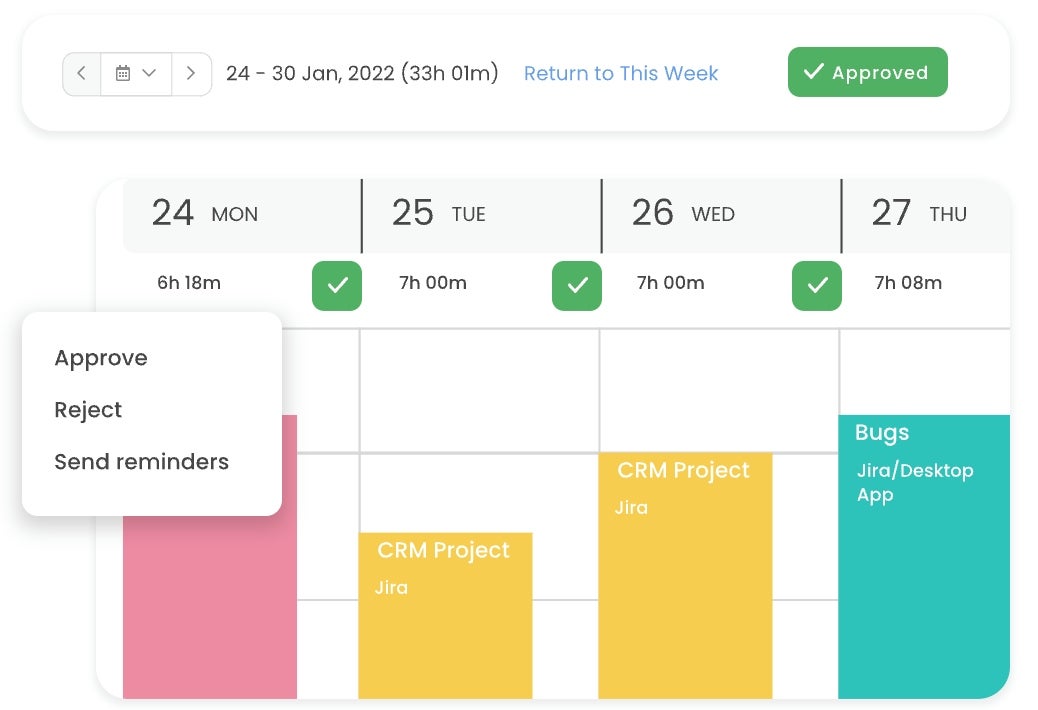
Top integrations
- Slack.
- Trello.
- Asana.
- Xero.
- Google Calendar.
- Microsoft Teams.
- Salesforce.
- ZenDesk.
Pros and cons
| Pros | Cons |
|---|---|
|
|
Why we chose TimeCamp
True to its name, TimeCamp offers a wide array of time-specific productivity features, from time kiosks to billing rates to attendance, that are matched by a few of the more general project management solutions. However, the tradeoff is that TimeCamp lacks some of the more robust project and product features, such as kanban boards.
Toggl Track: Best for employee time tracking

Toggl Track is another productivity app that focuses specifically on employee time tracking. The platform offers detailed time tracking, reporting and team management tools. With Toggl, you can set hourly rates, create invoices and track time to various projects and clients.
Use the reports to view accurate counts of billable and non-billable hours and compare estimated vs. actual time to make sure you’re staying within budget. You can also generate timesheet reports and balance employees’ workloads to keep them from burning out.
Pricing
- Free: Allows 5 users, unlimited time tracking and unlimited projects.
- Starter: $9 per user per month billed annually, or $10 billed monthly.
- Premium: $18 per user per month billed annually, or $20 billed monthly.
- Enterprise: Customized features — see sales for more information.
Features
- Advanced time tracking capabilities, such as automated tracking, personal tracking and even browser extensions.
- Customizable reports that can be exported and shared easily.
- Project management features, such as templates, predictive analysis, client profiles and project budgeting.
- Choose from web, mobile and desktop apps so you can work on multiple devices.

Pros and cons
| Pros | Cons |
|---|---|
|
|
Why we chose Toggl
Toggl is specifically designed for time tracking, and it delivers on this with an extensive feature set, such as its browser extensions that support time tracking inside other tools. However, because of this focused approach, it lacks certain other features, such as scheduling and advanced project management.
ClickUp: Best for workflow management

ClickUp is both a feature-rich and affordable productivity app, making it a great choice for teams of all sizes and budgets. ClickUp offers a range of capabilities to improve workflows and keep teams on track.
In the app, you can choose from a variety of work views, Agile workflows, task management, reporting and collaboration tools. ClickUp also offers workflow automation features, helping your teams improve efficiency and cut back on repetitive manual work.
For more information, read the full ClickUp review.
Pricing
- Free: Unlimited tasks and users.
- Unlimited: $7 per user per month billed annually, or $10 billed monthly.
- Business: $12 per user per month billed annually, or $19 billed monthly.
- Enterprise: More support and security — see sales for more information.
Features
- Browse 15 different project views including list, calendar, map and Gantt.
- Advanced reporting options including sprints, time, milestones and progress.
- Variety of options for collaboration like guest users, user tagging, sharing and emailing.
- Project customization and task automation.
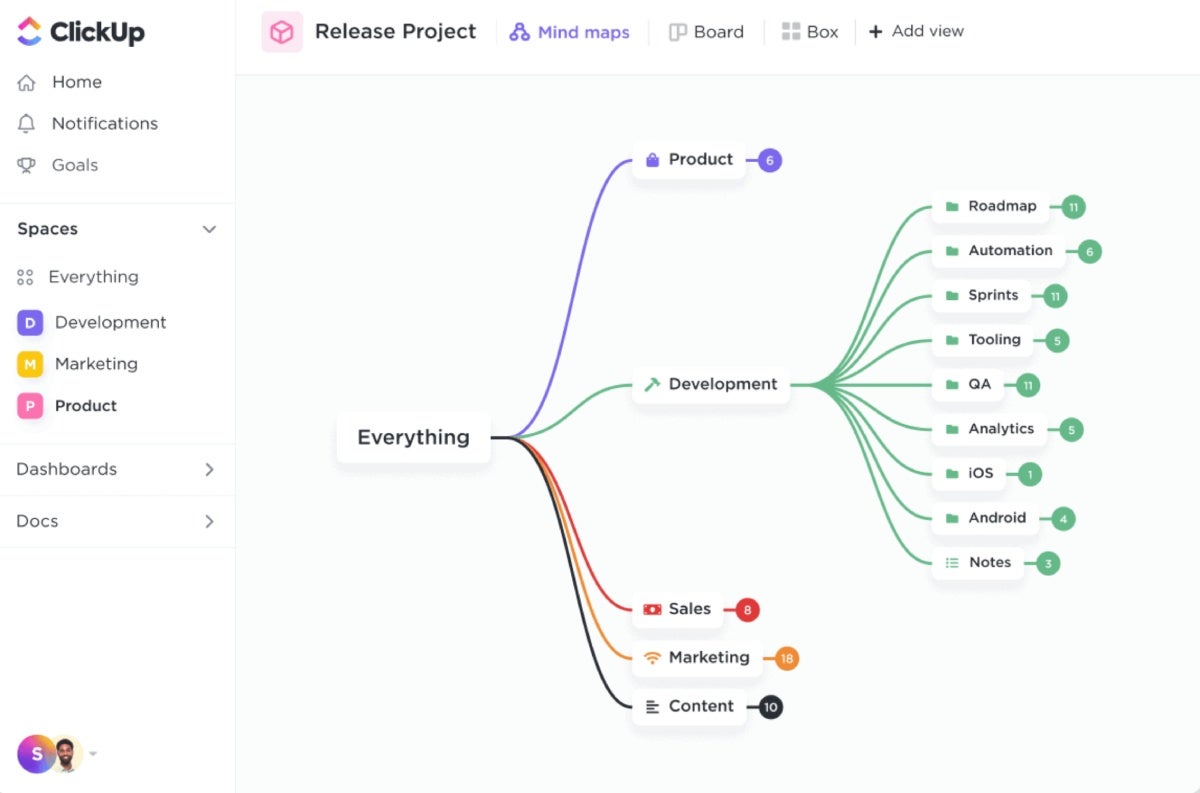
Top integrations
- Slack.
- GitHub.
- GitLab.
- Webhooks.
- Google Drive.
- Outlook.
- Microsoft Teams.
- Zoom.
Pros and cons
| Pros | Cons |
|---|---|
|
|
Why we chose ClickUp
ClickUp’s workflow automation builder helps teams become more productive and efficient by eliminating repetitive manual tasks. This productivity app also offers 15 project views to choose from, so you’re basically guaranteed to find one that works for your project.
Key features of productivity software
Time tracking
Time tracking helps your team track task duration, employee time, project time, billable time and much more. Many productivity apps limit this feature to the more expensive paid plans, so be sure to read the fine print on the pricing plans if this feature matters to you.
Gantt charts
Gantt charts — sometimes called “timeline view” — are one of the most sought-after work visualizations because they offer a timeline of due dates for tasks or projects along with those in charge of each part. If you want to monitor productivity, it’s one of the best features to have on both desktop and mobile apps.
Automation
For some teams, the most effective way to increase productivity is to automate repetitive tasks like scheduling and notifications. Some productivity apps limit the number of automations you have each month depending on your pricing plan, so consider how many automations your team might need before committing to a plan.
AI assistance
AI assistance can take many forms, such as editing and writing tools for emails and reports, workflow assistance, AI-generated estimates on productivity and predictive analytics based on past actions. Certain productivity apps include AI features automatically, while others charge an extra fee for them.
Performance reporting
Your team can’t become more productive if you can’t identify areas for improvement, and that’s where performance reporting comes in. The best productivity apps will analyze your team’s progress and recap each project in a visually appealing report that’s simple to understand. The software should also allow you to customize and save reporting templates for future use.
How do I choose the best productivity apps for my business?
Productivity apps offer a wide range of features and functionality, so before choosing one, you need to decide what your priorities are and what you are willing to compromise on. For instance, if you need advanced time tracking features, then you might not get advanced content creation features on the same platform.
You should also consider the learning curve offered by each platform and the technical savvy of your team. As an example, Todoist offers a very low learning curve, but its features are less advanced, making it more suitable for beginners. On the flipside, Teamwork offers advanced features and a higher learning curve, so it’s a better choice for users that are already familiar with productivity apps.
Pretty much all of the platforms listed here offer free trials as well as forever free accounts, so you can take the software for a test drive before committing to a paid plan. If you’re still not sold on your choice, consider opting for a month-to-month subscription to start out, so you’re not locked into an annual contract if you do decide you want to switch later on.
Benefits of productivity apps
As the name implies, productivity apps help improve your team’s productivity in a variety of ways. First of all, productivity apps improve visibility into task and project management, so you always know who is working on what at all times and can keep an eye on deadlines to be certain that nothing falls through the cracks.
Productivity apps also enhance team collaboration alongside visibility, helping your team work together more closely. Many of these apps provide comments, emoji reactions, chat messaging and other features to help your team stay in contact no matter where they’re working from.
Productivity apps also help eliminate manual tasks through automated workflows. Once you create the action triggers, the software will run through the sequence automatically every time someone completes the initial action.
The best productivity app should also provide reporting and give you insights into your team’s performance. These help your team increase productivity by identifying areas for improvement and demonstrating what is working well.
Methodology
To choose the best productivity apps, we consulted user reviews and product documentation, and we took advantage of free trials and free accounts. We prioritized features such as time tracking, project views, project templates, team collaboration and reporting when making our selection. We also considered other factors, such as ease of use, interface design, learning curve difficulty and customer support in addition to pricing.
Best for timeline management: Asana Best for enterprise workflows: Wrike Best for online collaboration: Notion Best for simple collaboration: Todoist Best for managing team performance: Teamwork Best for complex time management: TimeCamp Best for employee time tracking: Toggl Track Best for workflow management: ClickUp The right software will increase your team’s productivity rather than decrease…
Best for timeline management: Asana Best for enterprise workflows: Wrike Best for online collaboration: Notion Best for simple collaboration: Todoist Best for managing team performance: Teamwork Best for complex time management: TimeCamp Best for employee time tracking: Toggl Track Best for workflow management: ClickUp The right software will increase your team’s productivity rather than decrease…
